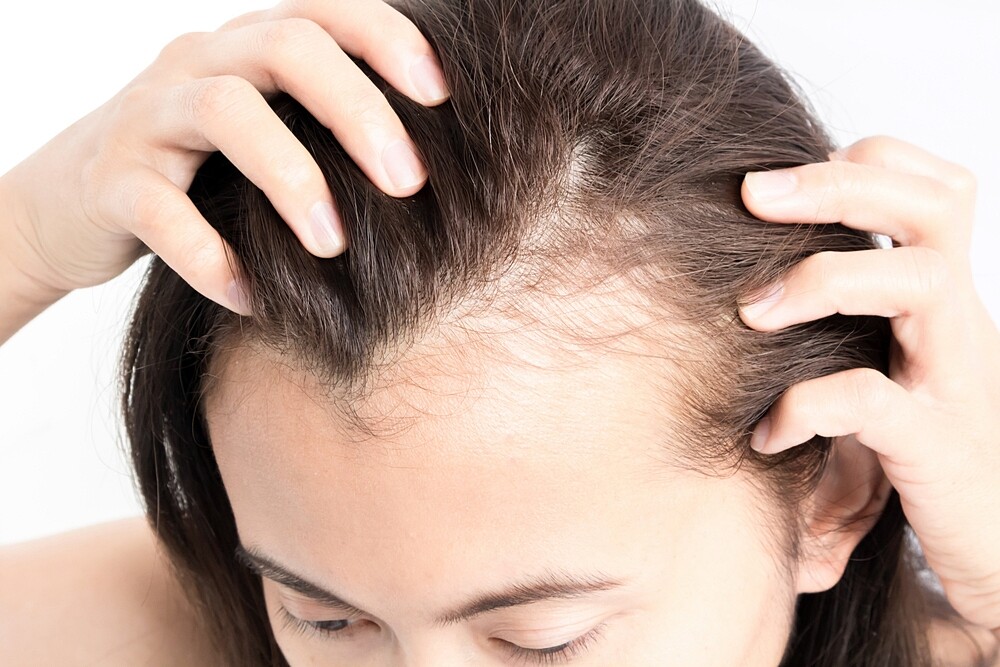Hair loss – for many women a horror scenario. Many charlatans use this fear and rip off those affected with obscure remedies. What really helps?
Hair loss – What is that actually?
Everyone loses a few hairs a day – that is no reason to worry. A visit to the dermatologist is necessary if you lose more than 100 hairs a day.
In the case of congenital or androgenetic hair loss, the hair usually becomes thinner first around the parting and then overall. The scalp shines through more and more.
With circular hair loss (Alopecia areata), an inflammation at the hair roots interrupts hair production. Baldness suddenly appears in one or more areas of the scalp. The areas become larger and in some cases can lead to complete hairlessness. The eyebrows and other body hair can also be affected. The nails can also change.
With diffuse hair loss, the hair on the entire head becomes thinner. Mostly another disease or deficiency symptom is behind it.
Who gets hair loss?
The congenital hair loss is genetically determined. It occurs mainly during puberty and the menopause – in other words, during the phases of life when the hormone balance of the woman changes. Experts estimate that almost every tenth woman is affected, and after the menopause even every fifth.
Circular hair loss occurs frequently in children and into adulthood and is probably a disorder of the immune system. The hair follicles – the small sacs around the hair root from which the hair grows out – become inflamed and repel the hair.
The diffuse hair loss can have various causes. Possible causes include severe infectious diseases such as scarlet fever or high fever, deficiencies caused by extreme diets, hormone fluctuations or shock. Medication, such as chemotherapy, but also psychotropic drugs, lipid reducers, beta-blockers, blood thinners or hormone blockers can also cause hair to fall out.
Which complaints should make me sit up and take notice?
If there is more hair on the pillow in the morning than usual, an extremely large amount of hair comes out when combing or washing the hair, and the hair looks lighter overall, it is time to go to the doctor.
How does the doctor determine whether I am affected?
The doctor first examines the scalp and hair growth: Is the hair evenly thinning, only on the parting or are there individual bald spots? He tries out whether the hair has already gone out by gentle plucking. If no reliable diagnosis is possible in this way, he takes a small tissue sample of the scalp and examines the number and structure of the hair follicles under the microscope.
A trichogram is often performed to determine the extent of hair loss. During this procedure, the doctor removes a tuft of hair from the area where the hair is going to fall out. He plucks another tuft of hair from an unaffected area. Under the microscope he compares the condition of the hair and hair roots. The modern TrichoScan method enables such an analysis without the hairs having to be torn out.
How can hair Loss be treated?
The congenital hair loss cannot be cured but only stopped. All remedies only work as long as they are applied. After the end of the treatment, the hair loss continues.
Ointment with the active ingredient Minoxidil, applied to the scalp, prevents further progression and in some cases even makes the hair grow again. Success can be expected after three months at the earliest. The active ingredient can irritate the scalp and trigger allergic reactions. Also available without prescription are tinctures with the active ingredient 17-alpha-estradiol. The active ingredient finasteride is only approved for men in Germany.
For severely affected women before menopause, a pill with anti-androgenic effects can also help. During the menopause, appropriate hormone treatment can slow down hair loss. In both cases the male hormones are displaced from their contact points in the cells. A cosmetic solution to the problem is hair transplantation, which is however very expensive.
With circular hair loss, the inflammation at the hair root can be treated with cortisone, a special light therapy and various stimulation therapies. In severe cases, immunotherapy with the active ingredient diphenylcyclopropenone (DCP) can be used. The doctor applies the aggressive tincture directly to the scalp and thus attracts the immune cells away from the hair root. Circular hair loss often stops of its own accord after some time, but can occur again and again.
Are there also gentle healing methods?
There are a variety of natural remedies that are supposed to help against hair loss. However, their effectiveness is controversial in most cases. Stay away from overpriced alleged miracle cures advertised on the internet or in magazine ads – these usually only benefit the seller, not the patient!
In the case of congenital hair loss, the intake of zinc, biotin and vitamin B6 is worth a try – even if an influence on hair growth has not yet been proven in scientific studies. The same applies to hair lotions, which usually contain caffeine and are said to revitalize the scalp. Zinc is also often recommended for circular hair loss.
How can I protect myself?
It is not possible to protect yourself against congenital and circular hair loss. However, diffuse hair loss, which is often caused by deficiency symptoms, can be prevented: by a balanced diet and refraining from extreme diets.
Incidentally, it is wrong to assume that regular haircutting can prevent hair loss: Hair loss occurs directly at the hair root and is not influenced by the length of the hair.

